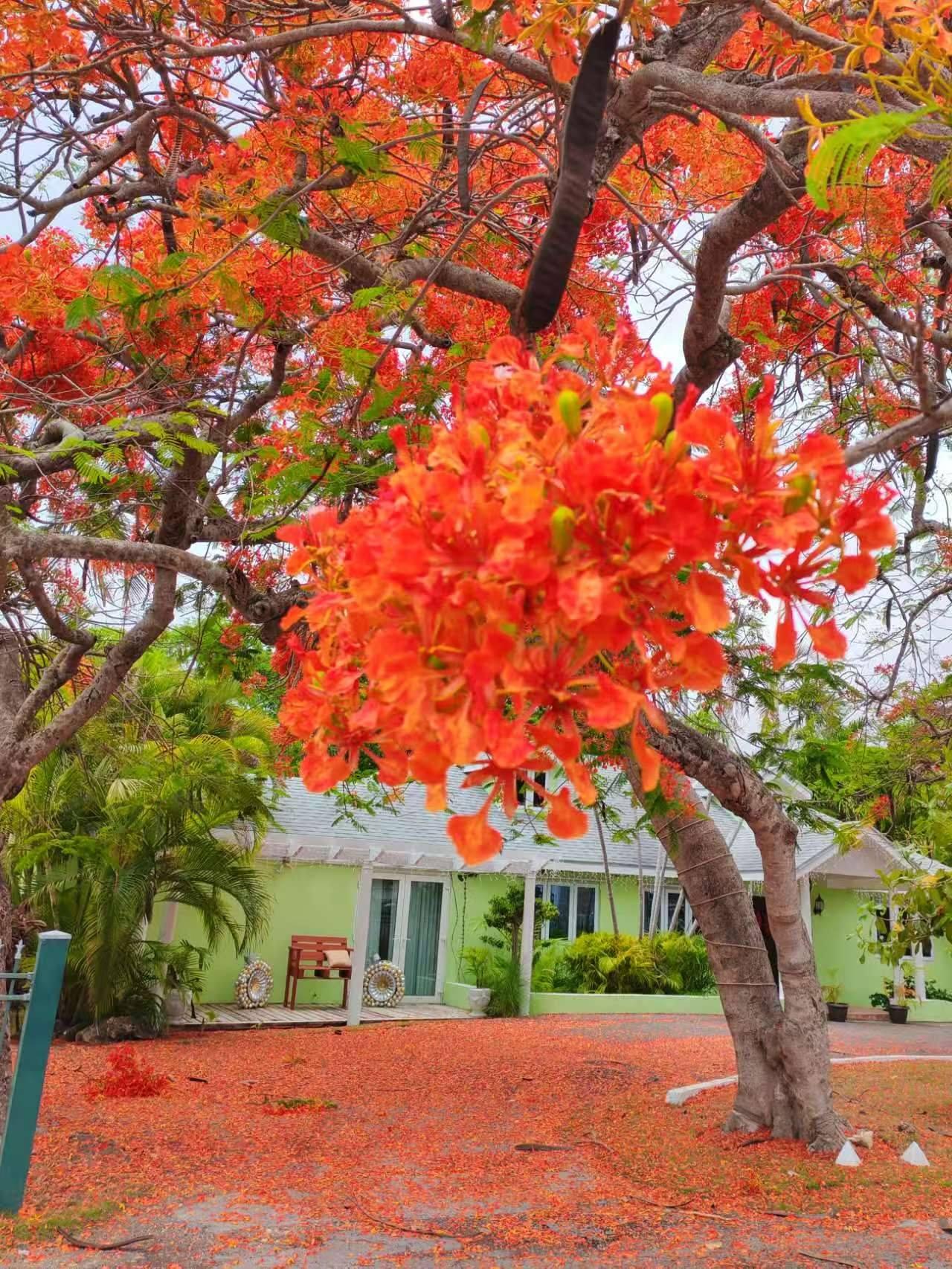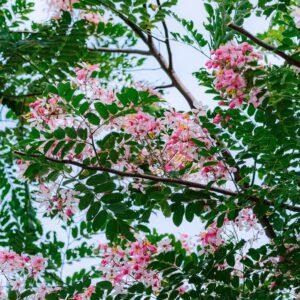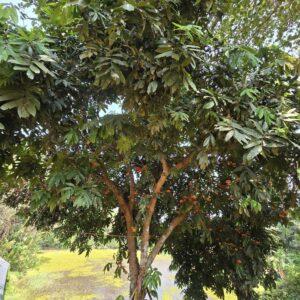Royal Poinciana Delonix regia – The Fiery Empress of the Tropics
Known as Gulmohar in India and Flame Tree elsewhere, the Royal Poinciana is a stunning tropical tree renowned for its bright scarlet-orange blossoms, broad umbrella-like canopy, and beautiful, feathery foliage. It is a representation of summer splendor in many cultures and is indigenous to Madagascar, where it has spread to warm climates all over the globe.
The Royal Poinciana, known for its quick growth, drought tolerance, and stunning beauty, is frequently planted as a statement tree in parks or along roadsides, or in larger gardens.
🌿 General Description
Delonix regia is the scientific term.
Common names: Flame Tree, Gulmohar, Royal Poinciana, Krishnachura, Flamboyant Tree
Kind of plant: Deciduous or semi-evergreen tree
Height: 30 to 40 feet (9 to 12 meters)
Distribution: 30–50 ft (9–15 m)
Foliage: Fern-like, bipinnate green leaves that fall during the dry season
Flowers: 4–5 inches in diameter, bright orange-scarlet, with five ruffled petals
Flowering time: Late spring to summer (April–July in most Indian regions)
Temperature and sunlight
Sunshine:
Needs direct sunshine for at least six to eight hours every day.
Flowering is significantly reduced in shaded environments.
Temperature:
Optimal development occurs between 20 and 35°C (68 and 95°F).
Has the ability to withstand extreme heat but not frost.
Minimum: 10°C (50°F) – susceptible to sudden cold weather.
After a dry spell followed by rains, blooming is more abundant in tropical regions.
💧 Watering Needs
When established, the Royal Poinciana is rather drought-tolerant, but it needs plenty of moisture throughout its formative years.
Young trees (first two to three years):
During dry conditions, water thoroughly two to three times a week.
Make sure the soil remains damp but not saturated.
trees at maturity:
During dry spells, water every 10–15 days.
Water less often during the rainy or colder months.
Waterlogging should be avoided since it may result in root rot. It’s critical to have a site with good drainage.
Requirements for Fertilizer and Soil
Soil:
Thrives in loamy, well-drained soil.
If the drainage is adequate, it may withstand sandy and rocky soils.
pH: Between somewhat acidic and neutral (6.0–7.5)
Fertilizer:
Give young trees a balanced NPK fertilizer (such as 10-10-10) every six weeks.
After maturity, fertilize twice a year: before the flower blooms (early spring) and after the blooming period has concluded.
Apply well-rotted manure or organic compost around the base every year.
When there is too much nitrogen in the diet, leaves can grow instead of flowers. Be careful to balance nutrients.
Maintenance and Pruning
The Royal Poinciana has the potential to grow to a large, spreading form. It is given shape and strength by regular pruning.
When to prune: Late winter or early spring, just before the blooms begin to appear.
Take away:
Branches that are weak or cross over
When growing near sidewalks, low-hanging branches are common.
Wood that is either dead or has been damaged by a storm
To establish a robust central leader and a balanced canopy, prune during the early years.
Methods of Reproduction
Seeds (the most popular method):
To soften the hard shell, soak seeds in warm water for 24 to 48 hours.
Germination takes place in 7–14 days after planting in damp potting mixture.
Although they grow quickly, it may take five to seven years for them to bloom.
Cutoffs (less common):
Apply rooting hormone to semi-hardwood cuttings.
Compared to seed propagation, rooting is less effective.
🌱 Once they are between 1 and 2 feet tall, seedlings can be transplanted outside.
🐛 Diseases and pests
Although typically robust, it may occasionally experience:
Insects, caterpillars, or beetles eating leaves
In overly humid or shaded environments, powdery mildew
If the soil remains damp for an extended period of time, root rot will develop.
Use neem oil sprays to treat small infestations.
To avoid fungal issues, make sure there is enough sunlight and air circulation.
⚠️ Factors to consider for space and root
Has a root structure that is shallow but aggressive.
Stay away from planting close to structures, walls, or underground pipes.
Ideal for public parks, huge gardens, or open areas.
Use of Landscaping
The center of attention in gardens or lawns
because of its broad canopy, it’s a shade tree
When coupled with opposing bloomers, such as Jacaranda, Bougainvillea, or Plumeria
Frequently employed as a roadside decoration for summer color
During blooming season, its carpet of fallen flowers makes a lovely, organic ground cover.
✅ Conclusion
The Royal Poinciana is a striking and vibrant option for tropical or subtropical gardens. Its flame-like flowers, elegant leaves, and spectacular summer display make it a plant that draws notice and respect. It is one of the most popular decorative trees in the world because it needs sunlight and room to grow, but it is also simple to maintain and offers a high return.
“
Royal poinciana
₨1,000.00
The magnificent tropical tree known as the Flame Tree or Gulmohar, but also as the Royal Poinciana (*Delonix regia*), is renowned for its stunning show of blazing red or orange blooms. Originally from Madagascar, it is now a popular ornamental tree in warm climates all over the globe. Its finely divided, fern-like leaves and wide, umbrella-like canopy offer exceptional shade. The magnificent color of the Royal Poinciana, which blooms from late spring through summer, completely changes the landscape. It needs a lot of sunlight and well-drained soil with moderate irrigation. This tree, which represents beauty and majesty in tropical and subtropical climates, is perfect for parks, avenues, or big gardens.





Reviews
There are no reviews yet.